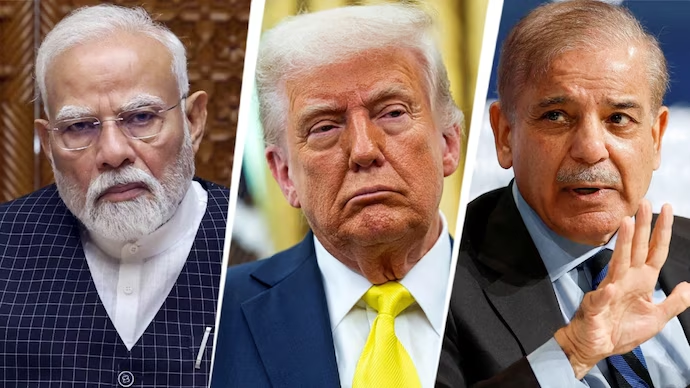Trump India Ceasefire and the 2025 India-Pakistan Conflict
The 2025 India-Pakistan conflict marked a significant escalation in the long-standing tensions between the two nuclear-armed neighbors, with the United States, under President Trump, playing a pivotal role in brokering a ceasefire. This article delves into the conflict’s origins, the international response, and the implications of the ceasefire, offering a comprehensive analysis of this critical moment in South Asian geopolitics.
The Spark That Ignited the Conflict
The Pahalgam attack on 22 April 2025 marked a turning point in India-Pakistan tensions. A suicide bombing in the Kashmiri tourist town killed 26 civilians, including foreign visitors, shattering years of fragile peace brokered by the 2020 Trump-brokered ceasefire. India swiftly blamed Pakistan-based Jaish-e-Mohammed, releasing intercepted communications allegedly linking the attackers to handlers in Rawalpindi. Islamabad denied involvement but refused to extradite suspected operatives. The massacre triggered nationwide outrage, with Prime Minister Modi vowing a “befitting response”, setting the stage for Operation Sindoor.
Operation Sindoor India’s Military Response
On 7 May 2025, India launched Operation Sindoor, a precision military strike targeting militant camps in Pakistan-administered Kashmir. Using Rudram-II anti-radiation missiles and Heron TP drones, the Indian Air Force hit suspected Jaish-e-Mohammed strongholds near Muzaffarabad and Kotli. The strikes, justified as “preemptive self-defense” after the Pahalgam attack, aimed to degrade infrastructure used for cross-border terrorism. Satellite imagery confirmed the destruction of training facilities and weapon depots. Pakistan condemned the operation as a “violation of sovereignty,” setting the stage for further escalation.
Pakistan’s Retaliation Operation Bunyan-un-Marsoos
Pakistan retaliated swiftly to India’s Operation Sindoor with Operation Bunyan-un-Marsoos, launching precision strikes on military installations in Jammu and Kashmir. Utilizing indigenous drones like the Burraq, Pakistan targeted command centers and radar stations, marking the first recorded drone battle in South Asia. The international community, including the UN, condemned the escalation, urging restraint. Pakistan justified its actions as defensive, citing sovereignty violations. The conflict’s rapid intensification set the stage for U.S. mediation, as global powers feared a full-scale war.
The Role of the United States
The Trump administration played a pivotal role in de-escalating the 2025 India-Pakistan conflict, leveraging its diplomatic influence to broker a temporary ceasefire. Former President Donald Trump, known for his unconventional approach, engaged in backchannel talks with both nations, emphasizing economic and strategic consequences of prolonged hostilities. The U.S. pressured Pakistan to halt Operation Bunyan-un-Marsoos while urging India to avoid further retaliation. This intervention underscored Washington’s enduring stake in South Asian stability, though critics questioned its impartiality given historic ties with India. The ceasefire set the stage for formal negotiations, as detailed in the next chapter.
The Ceasefire Agreement
The ceasefire agreement on 10 May 2025 mandated an immediate cessation of hostilities along the Line of Control (LoC), with both India and Pakistan withdrawing troops to pre-conflict positions. A hotline between the Directors General of Military Operations (DGMOs) was reinstated to prevent escalations, with daily communication protocols established. Scheduled talks on 12 May aimed to address unresolved territorial disputes and confidence-building measures, including cross-border trade resumption. The U.S.-brokered deal emphasized transparency, with third-party monitors verifying compliance, though skepticism lingered over long-term adherence.
Accusations of Ceasefire Violations
Following the 10 May 2025 ceasefire, both India and Pakistan accused each other of violating the agreement. India claimed Pakistani forces initiated cross-border shelling in Jammu, while Pakistan alleged Indian troops breached the truce in Kashmir. These accusations eroded trust, complicating the planned 12 May talks. The DGMOs exchanged heated calls, but neither side provided conclusive evidence. The lack of a neutral monitoring mechanism deepened skepticism, fueling fears of escalation. The cycle of blame threatened to derail diplomatic efforts before they began.
The International Community’s Response
The international community responded swiftly to the 2025 India-Pakistan conflict and the Trump-brokered ceasefire. The UN Security Council urged restraint, while the U.S. and EU praised the ceasefire but called for lasting dialogue. China, balancing ties with Pakistan and India, emphasized de-escalation. Regional bodies like SAARC and OIC echoed concerns, with the latter accusing India of aggression. Humanitarian groups pressed for ceasefire adherence to aid civilians, foreshadowing the crisis detailed in the next chapter. Global powers avoided direct intervention but warned against further violations, underscoring diplomatic fragility.
The Humanitarian Impact
The conflict caused severe humanitarian suffering, with civilian casualties estimated in the thousands due to cross-border shelling and airstrikes. Displacement surged as over 500,000 people fled border regions, straining already fragile infrastructure. Hospitals and schools were damaged, exacerbating the crisis. Immediate needs included emergency medical aid, shelter, and food supplies, with NGOs and UN agencies scrambling to respond. However, access remained limited in contested zones, delaying relief efforts. The Trump-brokered ceasefire eased hostilities, but long-term rehabilitation of affected communities remains a challenge, complicating post-conflict recovery.
Long-term Implications for India-Pakistan Relations
The Trump-brokered ceasefire in 2025 temporarily halted hostilities, but its long-term implications for India-Pakistan relations remain uncertain. While the pause averted immediate escalation, deep-seated mistrust and unresolved territorial disputes persist. The ceasefire could either serve as a foundation for renewed peace talks or fuel further hostilities if violations occur. Key factors shaping the future include:
- Political will—whether leaders prioritize dialogue over nationalist rhetoric.
- International pressure—sustained engagement from global powers to enforce compliance.
- Public sentiment—how civilian trauma influences demands for peace or retaliation.
Without addressing root causes, the ceasefire risks becoming another fragile truce in a cycle of conflict.
Lessons for International Diplomacy
The 2025 India-Pakistan conflict underscored the critical role of international diplomacy in de-escalating tensions between nuclear-armed states. The Trump-brokered ceasefire demonstrated how timely third-party mediation can prevent catastrophic outcomes, leveraging both public pressure and backchannel negotiations. However, the episode also revealed limitations—external interventions often lack sustained engagement, leaving underlying disputes unresolved. The urgency of diplomatic frameworks tailored to South Asia’s volatile dynamics became evident, emphasizing the need for proactive, rather than reactive, crisis management to avert future brinkmanship.

Conclusions
The 2025 India-Pakistan conflict and the subsequent ceasefire brokered with U.S. involvement underscore the fragile nature of peace in South Asia. While the immediate cessation of hostilities is a positive step, the underlying issues remain unresolved. This episode highlights the critical role of international diplomacy in managing conflicts between nuclear powers and the need for sustained engagement to address the root causes of tension.


